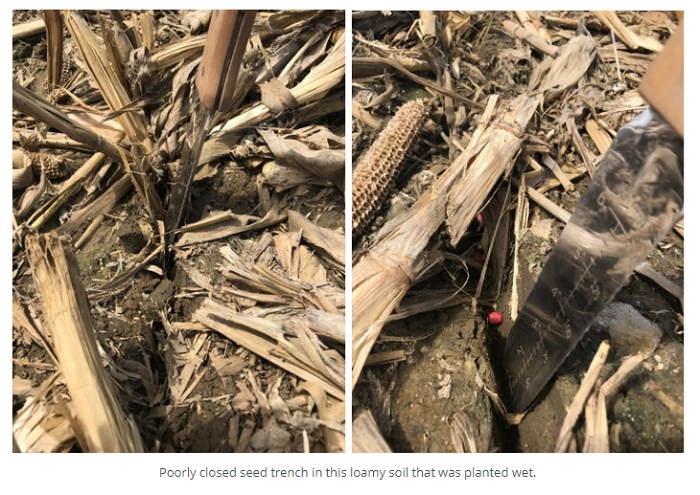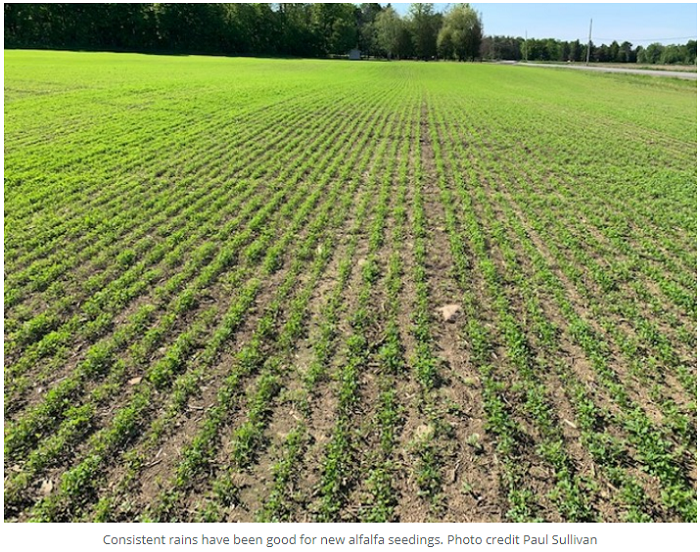Quote of the Week: “Lots of sins in the field – we need the rains to hide them.”
Conditions
Since May 1st the area has accumulated 475 crop heat units (CHU) as of June 11th, 150 less than the 30-year average. Rainfall accumulation is actually 10mm less than average at the Ottawa airport, but patchy weather patterns make it hard to generalize across the larger geography of our region. Weather was as good as it has been over the past weekend, but many fields remained unfit.
Planting in less than ideal soil moisture conditions means that many seed trenches were not closed well or at all, and smearing is common on clayey soils. This will be problematic if the weather turns dry. Crops will be especially vulnerable on clayey soils, where shrinkage from drying could crack open seed trenches even where they seem to be suitably closed. Pans from tillage on moist to wet soils are also common this year. It has been hard to avoid these problems this year, and even those who dutifully waited for things to get better found themselves at the end of the wire facing the decision to “plant now or not at all”.
Overall, crusting has not been common due to consistent rains, but silty and silty-clay soils are still at risk if heavy rains occur before emergence.

Forages
First cut is maturing, and the recent window of good weather meant everything that could got harvested. Some fields might have been harvested a bit too early, but for those producers the trade-off was necessary to replenish feed stocks. Yields were reasonably decent considering the conditions this spring, especially where fertility was applied. Hard numbers were difficult to come by, but 40-80% of the average number of bales per acre was mentioned. Much of what was harvested was grasses, as these conditions have been less favorable to legumes. Take what you can when you can, as maturing grasses rapidly lose feed quality.
New seedings of alfalfa are generally looking very good thanks to adequate moisture, which could be summed up by the comment “you could even get a catch with a Brillion”. Early-planted fields are between second and third trifoliate, with good to excellent plant counts and an expectation for first cut in about one month.

Alternative emergency forages are still on many minds, and cereals, legumes, and forage soybeans continue to be planted. Cereal rye is generally in head and being harvested. White mould in forage soybeans should be controlled for feed quality, but growers should be aware of that pre-harvest interval for their product of choice may be different for feed than for oilseeds. Check labels carefully and contact your company representative if you’re uncertain. If there is no reference to feed, forage, silage, or livestock, the product has not been tested for its safety in those situations and should be avoided.
If you are thinking of planting cover crops or forages on unseeded acres, make sure to contact your Agricorp adjuster to discuss claims and protocols. Claims are due by June 15th.
Alfalfa weevil pressure has been very low.
Cereals
With so little wheat being harvested this season, seed supply could be low. Those planning on planting wheat in the fall are advised to secure their orders as soon as possible.
Spring cereals are looking good to excellent as conditions have been favourable for them. Most fields have received fungicide applications. Planting continues as crop insurance deadlines came and went, highlighting the need for feed and straw. Some Septoria has also been spotted on spring wheat.

Corn
Over the past weekend, some of the best conditions to date saw a flurry of planting, and acres seeded rose to about 70% on average, ranging from only 40% in the flat clay plains north of the ridge in Prescott County to 100% in parts of Dundas and favourable pockets elsewhere. This was the first decent planting window in some areas.
Corn stage depends on the planting window that was taken, and ranges from not emerged up to four leaf (V4). Early-planted stands are surprisingly good. Stands planted the third week of May are not as good. If the crop was “mudded in”, the consequences of surface and sidewall compaction start to manifest when plants start to rely more on nodal roots – between V3 and V5.
Western Bean Cutworm traps in Quebec showed moth catches up significantly for mid-May, forecasting larvae to be out around the 10th-19th of June.
Pre-emergence weed control products are mostly applied, but some are applying pre- and post-emergence products at the same time in different fields depending on if and when they were able to plant.
Shorter-season hybrid seed is available, though most of what still be planted is likely to go for feed. Most of Eastern Ontario (areas A and B) could still plant according to the crop insurance calendar (extended to June 17th), but forecasts do not support optimism for that scenario. Remember to contact Agricorp by the 15th to open an unseeded acreage claim if you are likely to be in that position so that a file is opened if it should occur. Also remember that there are other support programs for uninsured acres and weigh your options. Seek advice and support for these decisions in your community and the industry.
Soybeans
The picture for soybeans is more positive, with about 90% of the crop in the ground in the region. The situation is less positive in certain areas, including Prescott, Renfrew, and parts of Leeds counties.
When the question of switching to shorter-season varieties came up, the consensus was generally to stay the course until June 15th, increasing density through higher populations and narrower row spacing to favour canopy closure. After this date, plant the longest-season variety that will reach maturity by the first killing frost. For more information, see the article from Horst Bohner, OMAFRA Soybean Specialist:
http://fieldcropnews.com/2019/05/is-it-time-to-switch-to-earlier-maturing-soybean-varieties/
Market Update (courtesy of Aubrie Mowat, BroadGrain Commodities Inc.)
Although the planting pace and progress has been less than desirable this spring we do have to be thankful for the pricing opportunities that have been a result of delays and other factors.
We saw USDA Crop Progress numbers on Monday afternoon, we now see 83% of US Corn Planted vs a five year average of 99%, while 62% of the crop has emerged compared to the 93% five year average. Although it does seem like North America is still behind there was a substantial amount of catching up that happened throughout the past week. According to USDA 60% of the soybean crop is planted compared to a five year average of 88%. One other thing I noticed is that 34% of US soybeans have emerged and at this time last year the number was much higher at 81%.
Yesterday the USDA revised their national corn yield down 10 bu/acre to 166 bu/acre in addition to planted area being reduced by 3 million acres. In addition to that, USDA also revised 19/20 US Ending Stocks to 1.675 billion bushels from the previous 2.485 billion bushels. December corn is only a couple cents off its highs (at the time of writing this) we saw the end of last month. USDA left the soybean yield unchanged at 49.5 bu/acre and did not adjust acres planted higher, perhaps we will see a revision to this number to account acres switched from corn in the June 28th report.
Moving forward the market will be focusing on weather forecasts, planting progress, crop conditions and of course trade tensions. It is important to stay connected to your market rep throughout busy seasons, reach out and discuss potential targets.”
Other
CFIA shared that glyphosate-tolerant wheat plants were found in a non-crop area of Washington state. Canola exports to China are still limited by political and regulatory obstacles.
As has been mentioned above, there are support programs available beyond crop insurance. See the following links for more information or talk to your Agricorp adjuster.
It’s been a tough year to be dependent on the land and Mother Nature for your livelihood, not only in this province but across the continent. Seek out help and support when you need it, but also offer it when you can and where you see it needed. If you don’t know anyone you feel you can reach out to, there are several stress and mental health resources and support centres listed at
http://www.omafra.gov.on.ca/english/about/mental-health.htm.
Source : Field Crop News